SPIR 2023: Key Findings
STATUS OF POLICING IN INDIA REPORT 2023: SURVEILLANCE AND THE QUESTION OF PRIVACY
Summary and Key Findings
The Status of Policing Report is the flagship report of Common Cause and the latest edition is the first of its kind study in India to explore public perception of privacy and surveillance. SPIR 2023 has been framed against recent developments like the Right to Privacy judgement by the Supreme Court and concerns about data protection. The report thus examines the evolution of Indian policing within the ambit of the exponential growth and deployment of surveillance technologies and their implications for the privacy of citizens.
SPIR 2023 has looked into the complexities surrounding digital surveillance, the extent of surveillance by government agencies and private entities, allegations about the illegal deployment of Pegasus by the government and the enactment of the Criminal Procedure (Identification) Act, 2022, which grants the police power to collect the biometrics of suspects. The aim is to gauge public opinion about these issues.
The study by Common Cause and CSDS-Lokniti employed the following research tools:
- Face-to-face interviews with 9,779 people across 12 Indian states and Union Territories.
- Focus group discussions (FGDs) with domain experts and in-depth interviews with serving police officers.
- Filing Right to Information applications for latest government data and analysis of official data on surveillance, CCTVs in police stations, cybercrime rates, and monitoring cells.
- Analysis of media coverage of surveillance over a period of one year across six major media outlets to identify broad trends in coverage.
Overall, SPIR 2023 highlights the need for increased awareness and understanding of critical issues and addresses the disparities in trust and support for government and non-governmental surveillance.
Some of the broad findings of SPIR 2023 are:
Official Data Trends
Despite the limited availability of official data on compliance with the Paramvir Singh judgement which mandates the installation of CCTV cameras in police stations, we have analysed the existing data to identify overarching trends in surveillance across India.
- The number of CCTV camera feeds available with the police, including private ones, is significantly lower than the actual overall number of cameras within city limits.
- There is no statistically significant relationship between the number of CCTV cameras and crime rates from 2016 to 2020. In other words, the number of cameras available with the police does not have any statistical impact on the rate of cognisable crime, murder, and auto/ motor theft.
- There is no statistically significant relationship between the number of CCTV cameras and crime rates from 2016 to 2020. In other words, the number of cameras available with the police does not have any statistical impact on the rate of cognisable crime, murder, and auto/ motor theft.
- Even amongst states that register a high number of cybercrimes, the infrastructure to solve such cases do not match the high volumes of registration of cybercrimes.

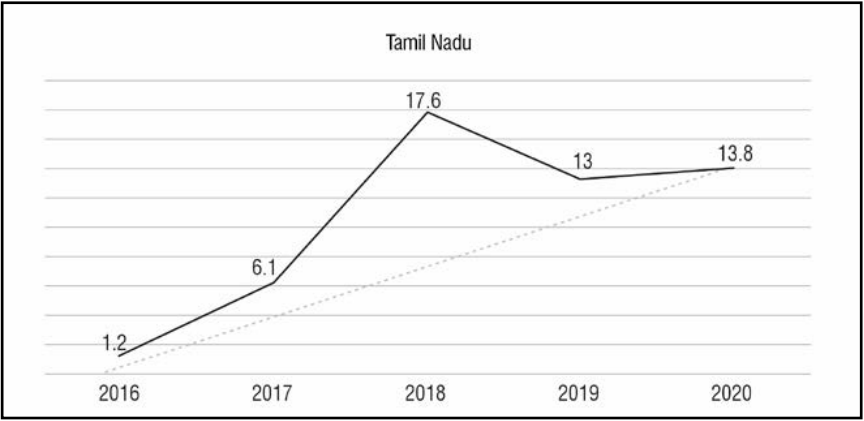
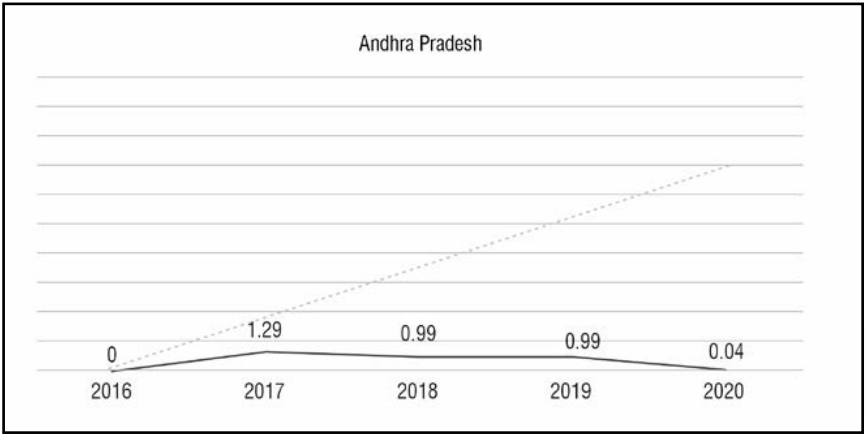
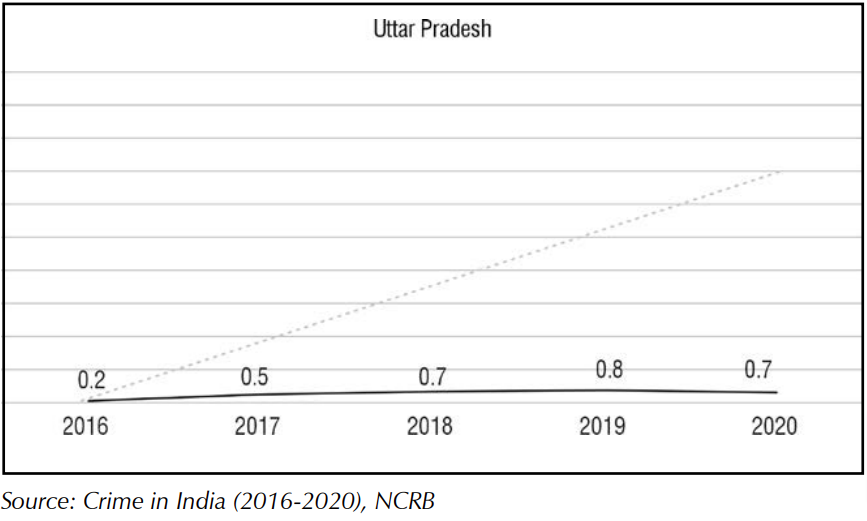
- The conviction rates for cybercrimes across the country are lower than the corresponding rates for total cognisable crimes under the Indian Penal Code (IPC) and Special and Local Laws (SLL). In Assam, for instance, despite 6096 persons being arrested in 2021 for cybercrimes, the charge sheeting rate was about 16 percent and the conviction rate was just 2.2 percent.
- States have started registering an increasing number of cybercrimes under the subhead ‘political motives’. While the term itself is not defined by the National Crime Records Bureau (NCRB), its number has increased nearly nine-fold over a five-year period, from 40 in 2016 to 356 in 2020. Notable states are Tamil Nadu, Uttar Pradesh and Andhra Pradesh.
Experts’ Opinions on Surveillance and Right to Privacy in India
The topic of surveillance rarely breaks out of the domain of expert conversation into broader public discourse. This has resulted in a lack of awareness about the potential threats of surveillance technologies. We aim to bridge this gap in SPIR 2023 via focus group discussions. The FGDs provide context to the survey findings on the general public’s opinions. The following are some of the significant findings from the FGD and interviews.
- The experts broadly agreed that while surveillance is being conducted by various actors—state agencies, private entities, individuals—it was the unchecked targeted surveillance by the state that was the biggest cause for concern. Some of the participants felt that surveillance by private companies was being used for stifling dissent or manipulating electoral processes.
- While the participants differed on the efficacy of mass surveillance technologies such as CCTVs for controlling crime, there was consensus that oversight and accountability were required.
- The FGD participants were of the opinion that general support for surveillance technologies stemmed from ignorance of the right to privacy. It was felt that surveillance is viewed as an effective tool for public safety and national security by the masses. Some of the participants also pointed out the class differences in attitudes, with the poor being less likely to support surveillance by the police or the state.
- Participants, as well as serving police officers, pointed out that police forces in India lack the necessary infrastructure, capacity, and legal mechanisms to conduct proper surveillance. The ground reality is that the police are unable to use surveillance technologies effectively.
- Some participants pointed out that social prejudice can be keyed into the technology as well, leading to biased algorithms which could subvert the criminal justice system.
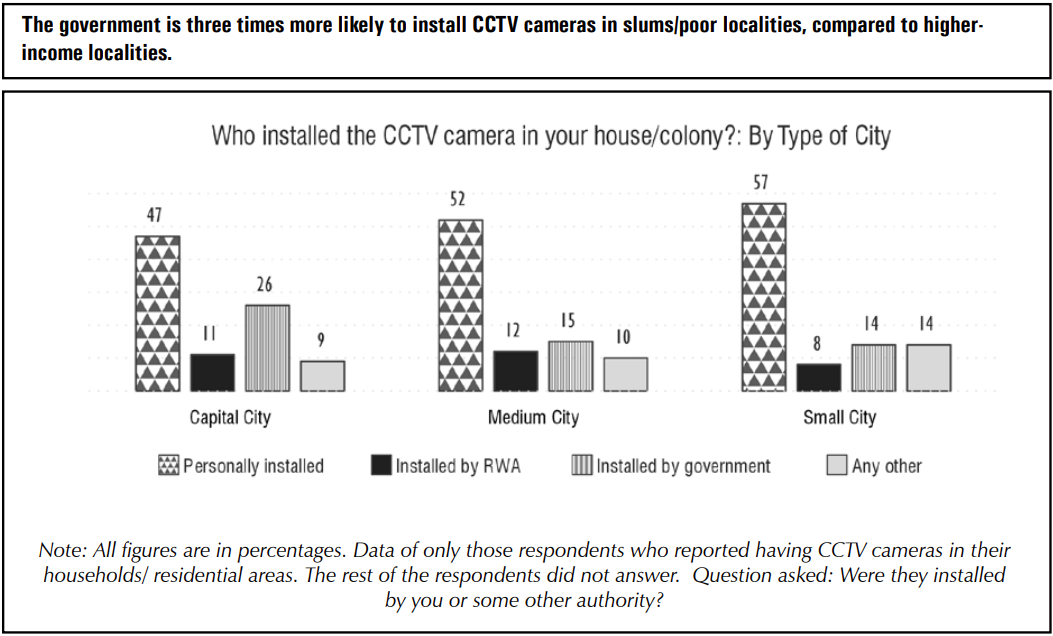
Prevalence of and Perceptions of CCTV Cameras
CCTV cameras are among the most pervasive forms of digital mass surveillance, and yet regarded as seemingly harmless. Proponents argue that they help prevent crime and ensure public safety, but there is little empirical data to support these claims. Despite this, the general public’s perception as indicated by the survey is largely in favour of the continued use of CCTVs, even if it means accepting the risks of mass surveillance. However, support for CCTV cameras declines significantly among respondents with lower levels of education and socio-economic status.

- Half of the respondents (51%) said that CCTVs have been installed in their households/ colonies. While high-income groups are more than three times more likely to have CCTV coverage in their residential areas compared to slums and poor localities, the government is three times more likely to install CCTV cameras in slums/ poor localities, as opposed to higher-income localities.
- The poorest sections are the least likely to support the installation of CCTVs at any location— whether at the entry of homes, inside the house or at places of employment.
- One out of four people strongly feel that CCTVs carry a risk of illegal mass surveillance. On the other hand, nearly three out of four people strongly believe that CCTVs help monitor and reduce crime.
- People with higher levels of education are more likely to believe that CCTVs help in crime reduction, and are less likely to believe that CCTVs can be misused for illegal mass surveillance.
- Two out of five people are aware of incidents of CCTV footage tampering or manipulation

- Forty-four percent of people believe that CCTV cameras in police stations are very helpful in preventing human rights violations against those in custody. Close to half of the respondents strongly believe that interrogations by the police should be recorded on CCTVs.
Government and Police Surveillance
- The findings of SPIR 2023 are consistent with previous findings (SPIR 2018) that people are generally satisfied with the performance of the police. In line with this trend, the survey data shows that people largely support the use of drones and facial recognition technology (FRT) by the government.
- About half of the respondents supported the collection of biometric details of suspects, including undertrials. Adivasis and Muslims are the most critical of the police collecting biometric details of suspects.
- More than one in two strongly support the use of drones by the armed forces, government, and the police. However, farmers and the poorest are most likely to oppose drone usage by government agencies.
- Half of the respondents fully support the use of FRT by the government and police. They are four times more likely to strongly support the use of FRT by government agencies, compared to its use by private entities.
- Nearly two out of three respondents believe that political parties surveil citizens for electoral gains
- Forty percent of people believe that police should not have the freedom to check people’s phones without a warrant. Two out of five people believe that police should always obtain a search warrant before tracking anyone’s laptop or phone
- People feel a greater need for an independent forum to deal with illegal surveillance by government agencies such as the police, as against illegal surveillance by private companies
- Only 16 percent of people believe that the police are adequately trained to use surveillance technologies such as CCTVs, drones and FRT
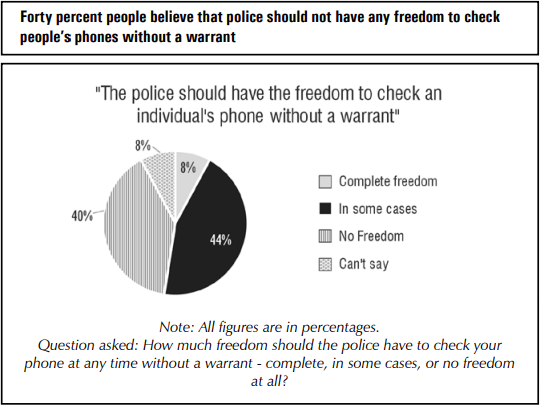
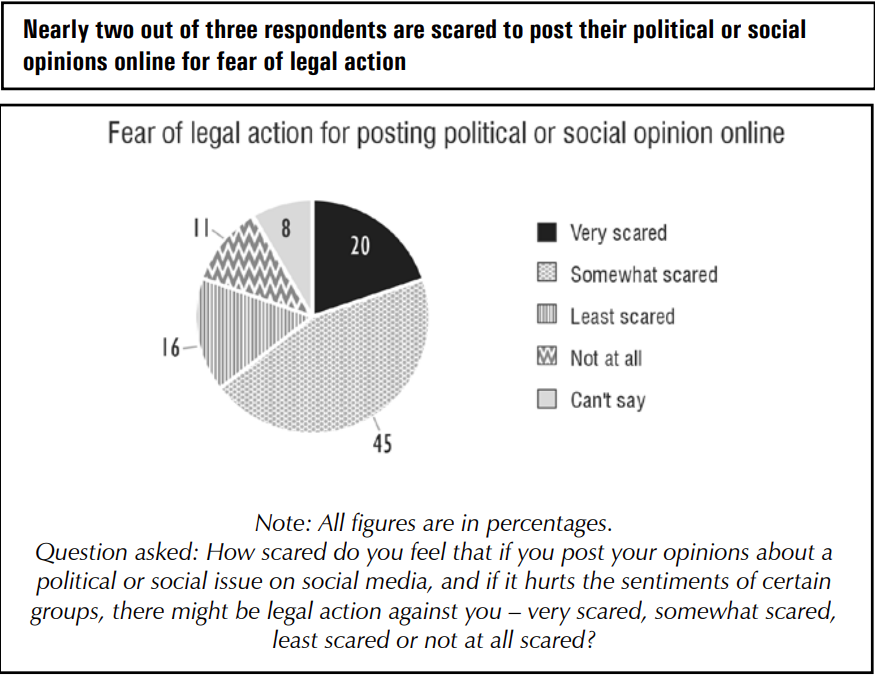
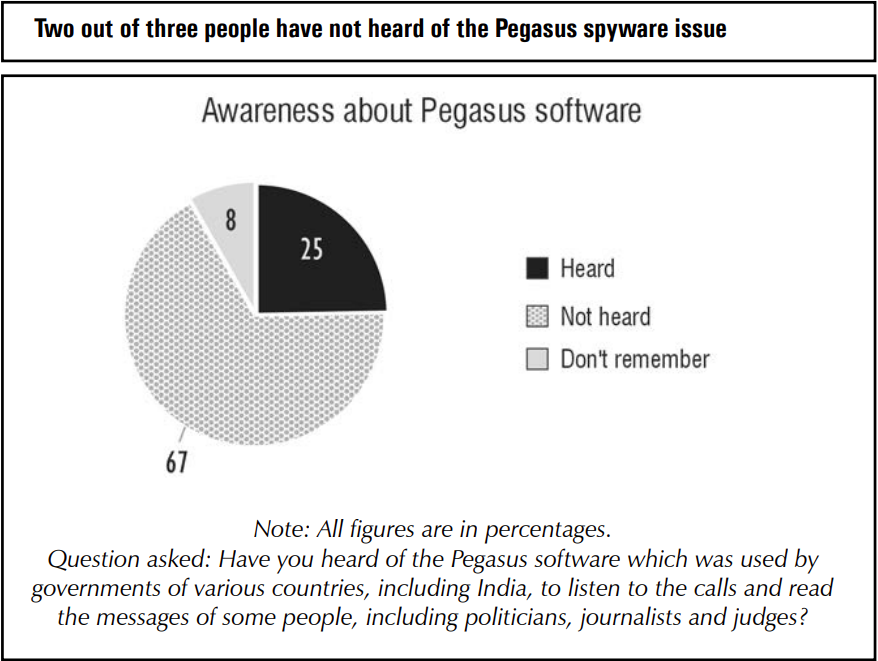
Right to Privacy and Freedom of Speech
The views expressed in FGDs stand in stark contrast to the opinions expressed by the common public. The survey data suggests that a large proportion of people support the use of government surveillance to curb protest and freedom of expression. Additionally, while people expressed fear about sharing their opinions online, they paradoxically supported government surveillance of online and offline activity, including the use of illegal spyware such as Pegasus. Moreover, public awareness about Pegasus and the Puttaswamy judgement is extremely low.
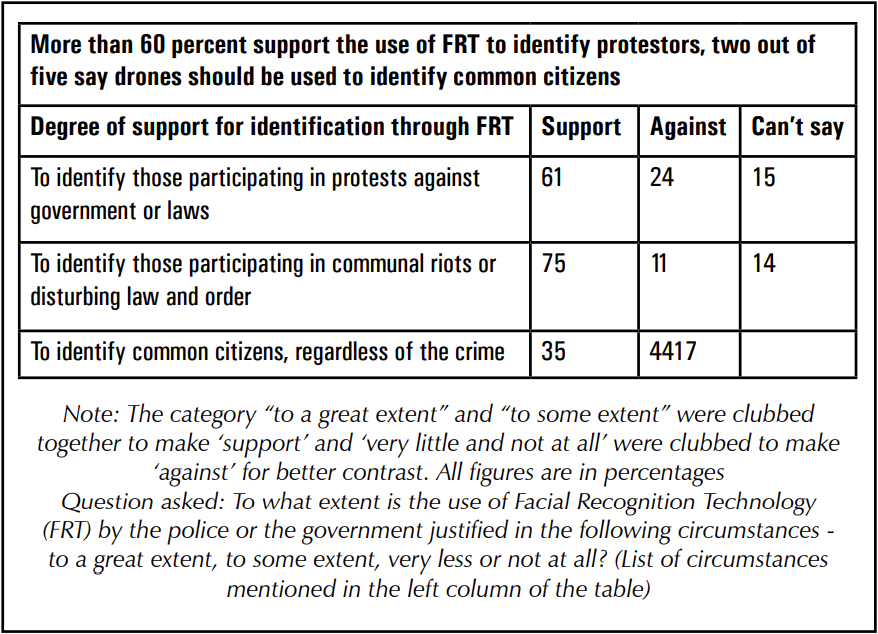
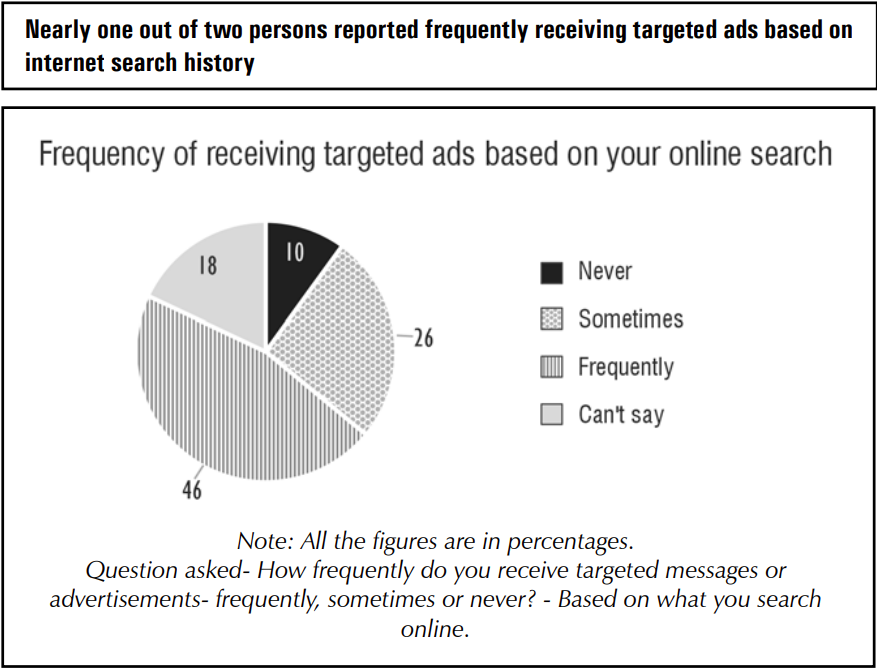
- Over half of the people strongly justify using CCTV cameras to control protests. People from small cities and poor backgrounds are least likely to support the use of CCTVs to curb political movements or protests.
- One in five believes that it is right for the government to monitor people’s social media posts.
- Large sections of the respondents feel government surveillance by CCTVs (52%), drones (30%) and FRT (25%) to suppress protests and political movements is justified to a great extent. Respondents from Punjab are least likely to support government surveillance of protests while those from Gujarat are most likely to support it.
- Nearly two out of three respondents are scared to post their political or social opinions online for fear of legal action.
- Two out of three people have not heard of the Pegasus spyware. More than a quarter of the respondents feel that surveillance of MPs/MLAs and other politicians using spywares such as Pegasus is completely justified.
- Nearly one out of three respondents strongly support drone usage by the government to curb political protests
- More than 60 percent of the public support the use of FRT to identify protestors, while two out of five say drones should be used to identify common citizens.
- Only about one in six respondents (16%) have heard about the right to privacy (Puttaswamy) judgement passed by the Supreme Court. People from upperclass sections with college degrees and above are most likely to have heard about the judgement.
- About one out of two persons fully agrees with the decision in the Supreme Court judgement on the right to privacy.
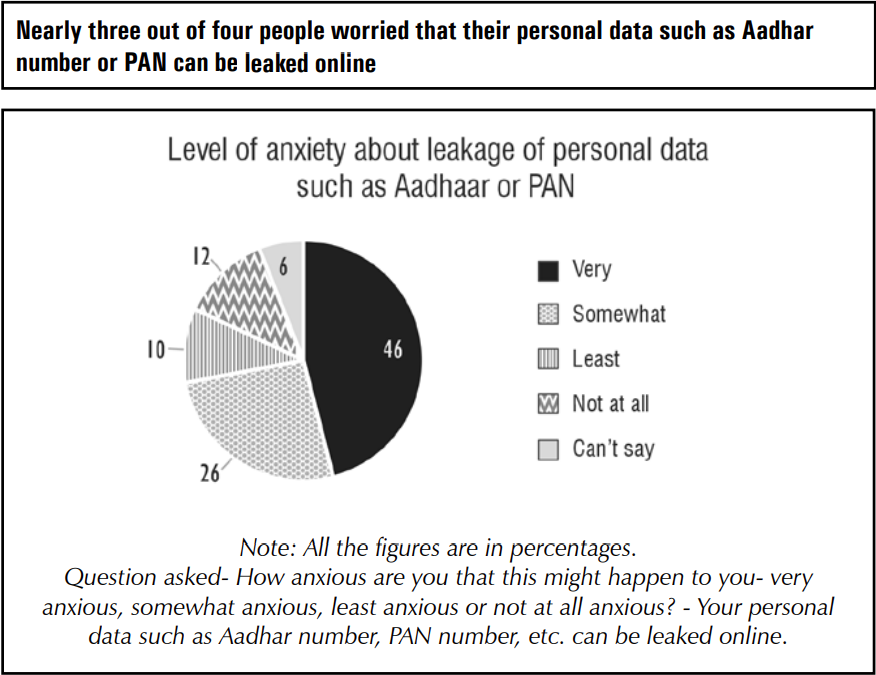

Surveillance by Private Entities
The public is generally in support of the government’s use of surveillance technologies, but there is a notable level of concern among people about the safety and misuse of their personal data by private entities. This is particularly evident when it comes to government-issued identity documents like Aadhaar or PAN cards. People are especially apprehensive about sharing these details with private companies. The survey also indicated that people have been subjected to online tracking by private companies and received targeted ads based on their profiles and past activities.
- About two out of three respondents are concerned that data collected by private entities can be misused.
- Nearly one in two frequently receives targeted ads based on their online search history.
- One out of five people are not at all comfortable sharing their Aadhaar details with private agencies.
- Forty percent of people are very anxious that information provided by them online can be misused.
- Forty-four percent of the people are very anxious about unknown persons/companies tracking their bank account transactions.
- Nearly three out of four people worried that their personal data such as Aadhar number or PAN can be leaked online.
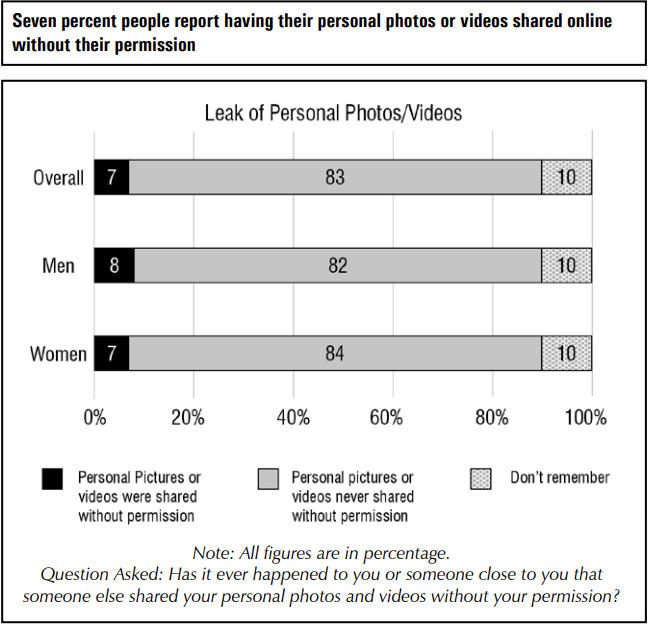

Hacking and Cybercrimes
The safety of personal data - of a financial nature especially - is a major concern for the general public. This is further supported by the rise in reported cybercrimes as per NCRB data since the onset of the Covid-19 pandemic, and the survey findings reflect this anxiety. Additionally, the survey sheds light on the use of digital financial platforms based on caste, class, and age.
- Two out of five people are anxious about hackers accessing the information on their phones without their consent or knowledge.
- Three out of four people are anxious about an unknown person/company accessing their email accounts.
- Seven percent people report having their personal photos or videos shared online without their permission
- Nearly one out of three people do not use any form of digital banking such as United Payments Interface (UPI), digital wallets, debit/credit cards or net banking. Older respondents are least likely to use payment wallets or feel comfortable with such apps.
- Scheduled Caste respondents were least likely to use digital banking while upper caste respondents were most likely to.
- Twelve percent of the respondents reported that they have been victims of online financial fraud.

Analysis of Media Content on Surveillance
In order to gain insights into the media coverage of surveillance the research team conducted an analysis of relevant news stories over a period of a year from July 1, 2021, to June 30, 2022. A total of 1,113 news stories from six media outlets (three Hindi and three English) were coded and analysed to identify broader trends such as the type of stories, their slant and sources used.
- Nearly three out of four news items rely on government agencies as their primary source.
- One in four stories has a pro-surveillance approach.
- Times of India and Dainik Jagran were most likely to have a pro-government slant on surveillance, while The Wire was most critical of the government. Over half of Times of India stories are pro-surveillance.
- Nearly two of three news items are on the use of surveillance technology for public safety and order. Only a quarter of the news stories focus on human rights.
- Stories on CCTVs and drones are least likely to include debates around their legality or right to privacy.
- Of the total sampled stories, less than 14 percent mention right to privacy or the legality of the surveillance.
NEXT »



